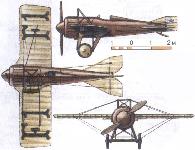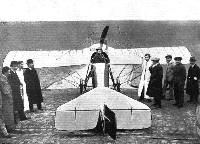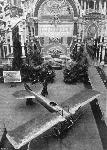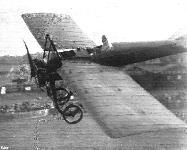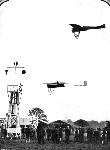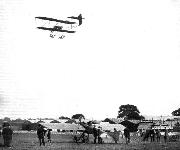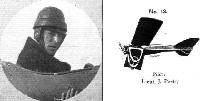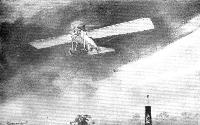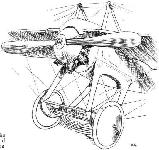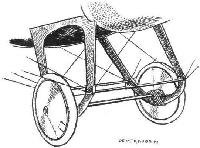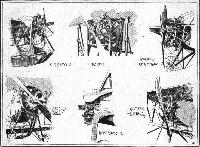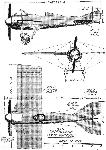А.Шепс Самолеты Первой мировой войны. Страны Антанты
Главный конструктор фирмы "Депердюссен" Луи Бешеро совместно с голландцем Фредериком Колховеном создали этот самолет специально для участия в гонках на приз Гордона-Беннета. И хотя эта машина не участвовала в войне, да и построена была в нескольких экземплярах, о ней стоит рассказать. Конструкция этого самолета во многом определила облик истребителей Первой мировой воины. К тому же, именно ей принадлежит слава пересечения отметки в 200 км/ч. В 1913 году на самолете "Депердюссен-гоночный" поставлен рекорд скорости 200,89 км/ч, а позднее и 203,85 км/ч. Конструкция фюзеляжа овальной, сигарообразной, обтекаемой формы, предложенная швейцарцем Юджином Бухонетом, получила название "монокок". Деревянный каркас обтягивался по дополнительным рейкам полотном, либо покрывался фанерным шпоном.
Обтянутое полотном крыло крепилось к "кабану" и шасси двумя парами растяжек из стального троса. Для обеспечения максимальной скорости крыло имело очень малую площадь и размеры, что ухудшало взлетно-посадочные характеристики самолета.
Оперение имело конструкцию и формы, аналогичные конструкции оперения самолета Депердюссен тип В. Шасси имело каркас из металлических профилей, резиновую шнуровую амортизацию.
Двигатели сдвоенные 14- и 18-цилиндровые, воздушного охлаждения, ротативные, звездообразные "Дабл Лямбда" или "Дабл Рон 18Е" (160л. с.). На двухлопастный винт устанавливался кок.
Осенью 1913 года во Франции разразился скандал, связанный с растратой 28 миллионов франков на строительстве боевых кораблей для французского флота, в которой был замешан Арман Депердюссен. Его арестовали. Вскоре фирма "Сосьете Пус лес Аппарельс Депердюссен" была ликвидирована. В 1914 году она была приобретена Луи Блерио и получила название "Сосьете Пур л'Авиасьон эт сес Деривс"
Показатель||"Депердюссен гоночный"/"Депердюссен рекордный"
||1912 г./1913 г.
Размеры, м:||
длина||6,09/6,09
размах крыльев||7,15/6,63
Площадь крыла, м2||9,86/9,00
Вес, кг:||
максимальный взлетный||640/680
Двигатель:||"Дабл-Лямбда"/"Рон 18Е"
мощность, л. с.||160/160
Скорость, км/ч||205/209
Дальность полета, км||?/100
Экипаж, чел.||1/1
Показать полностью
Журнал Flight
Flight, February 10, 1912.
THE 100-H.P. DEPERDUSSIN RACING MONOPLANE.
THE performance of that magnificent pilot, Vedrines, mounted on this new product of the Deperdussin firm, in establishing a new set of world's speed records from 5 to 150 kiloms., is yet another fact in support of our oft-repeated assertion that the organisation of Armand Deperdussin is one of the most enterprising and vigorous among the French industry. The machine with which this feat was accomplished has for some considerable time past been the special study of their chief engineer, M. Bechereau, one who has earned considerable respect in France, and even on this side of the Channel, by his most original and sound ideas. In order to arrive at the phenomenal speeds of which this machine has proved itself capable, the designer has in no way sacrificed any of its inherent qualities of safety in order to achieve his end. He has sought to attain the solution of the problem by reducing the head resistance of the machine as a whole to a minimum and by special study of the wings, rather than by any such inadvisable expedient as reducing the supporting surface.
The growing trend of opinion in favour of the torpedo type of body has gained another adherent, for in the machine at present under review this feature has been incorporated for the first time in the Deperdussin design. The main body proper consists of a lattice girder which tapers towards the rear, of exactly the same type as, but of more generous dimensions than, that employed on the ordinary type of machine. Throughout its whole length this girder is encased by a shell of three-ply wood, enough being cut away on a level with the back of the wings, in order to accommodate the pilot.
The form of the wings is rather peculiar in view of the general acceptance of the tapering tip. In the case of this machine, however, the wing tapers from the tip to the root, butterfly-like, a system which has some points to commend it, in that the chord is least where the relative current of air is strongest, and that the enlarged ends of the wings are better able to counteract the tendency of the engine torque reaction to interfere with its natural balance. One thing is certain, that is, that it is possible to get a much more powerful warp than if the wings tapered in the opposite sense. As a further advantage it is claimed that the span may be reduced without interfering with its flying qualities. In cross section the wings exhibit a very slight camber, and this, combined with the fact that they are set at an angle of only five degrees incident to the relative wind no doubt chiefly accounts for the remarkable speed this machine has shown. The trailing edge is of flexible construction so that any temporary increase of pressure beneath one wing may be automatically released. Hickory is employed for the spars, and the ribs are of I section, constructed from pine and ash. These same materials are used to form the framework of the stabilizing surface at the rear, and in both cases three-ply wood is made use of to form the leading edge. The fabric covering of the wings is treated, as is customary in the Deperdussin workshops, by several successive coatings of special varnish which renders it impervious to water, oil and petrol. Stranded steel cables are provided to take the weight of the machine in flight.
Despite the amount of criticism that was applied to the Deperdussin-type of landing gear at the time of its first appearance at the Paris Aero Show over a year ago, and has been applied at occasional intervals since then, this section of the machine has not, even in this latest model, where landing is effected at speeds in the neighbourhood of 90 miles an hour, undergone the slightest change. This, in our opinion, is sufficient evidence of the soundness of its design. Quite novel is the fitting of the rear skid. Only that part which rubs on the ground emerges from the fuselage, the remainder, together with the elastic cord attachment which endows this organ with flexibility, is disposed in its interior, a feature making for lessened head resistance and cleanness of design. The tail has been particularly low built in relation to the front part of the machine, in order that it may leave the ground more quickly, and pull up in a shorter time on landing.
As regards the tail, the arrangement of this organ is essentially the same as on the firm's less speedy machines, excepting that the surfaces are applied without the use of bracing wires or strainers. The controlling arrangements are absolutely identical with those on the standard types of this firm's productions - a wheel mounted vertically at the centre of an inverted U-shaped sweep of wood being pulled towards and pushed away from the pilot to effect elevation and depression, while rotating it laterally actuates the warping. One difference is evident, however, that the control is, in this machine, totally enclosed in the fuselage. The rudder is operated from a pivoted foot-bar.
Tractive force is derived from a 14-cylinder 100-h.p. Gnome engine direct coupled to a rapid propeller of 8 ft. 3 ins. in diameter. The main support of the engine is at the rear, but there is also a subsidiary support in front composed of three steel tubes arranged Y fashion. A thin shield of aluminium covering the motor effectively prevents any oil from being thrown in the direction of the pilot.
Flight, November 9, 1912.
THE PARIS AERO SALON.
Deperdussin.
PERHAPS no firm can be said to have made more progress than has the Deperdussin concern in France. Two years ago they had a small stand in a more or less insignificant position in the gallery, where they showed quite a neat and promising monoplane, which had the peculiarity that it was driven by a six-bladed propeller. By last year they had grown to be one of the chief monoplane manufacturing concerns in France, and this year they come to the Salon with the Gordon-Bennett Cup to their credit. On their stand they exhibit the machine with which Vedrines achieved this honour - a monocoque miniature in everything except the engine, which is a colossal rotary Gnome of 140-h.p. Naturally, as it is a speed machine - its flying speed is well over 100 m.p.h. - everything possible has been done to cut down head resistance to a minimum. Thus the body is of perfect streamline form, and of sufficient girth to totally enclose the pilot, leaving only the upper half of his head exposed. The wings are practically flat, and their average chord measurement cannot be more than 4ft., while they do not span more than 22 ft.
Over the front of the rotary motor is applied a semi-spherical dome through which the propeller of an unusually coarse pitch projects. This dome closely follows the bluff lines of the front of the fuselage, but there is sufficient clearance between it and the oil shield to admit air. Scarcely anything simpler than the racing, version of the Deperdussin chassis can be imagined. It is constructed of multiple-ply wood bound with canvas. Disc wheels are used.
There is shown on the same stand a very similar model, a single-seater with an 80-h.p. motor. But this has no cowl over the front of the engine.
Flight, February 8, 1913.
WHAT THERE WILL BE TO SEE AT OLYMPIA.
THE MACHINES.
The British Deperdussin Aeroplane Co., Ltd.,
Will be showing two monoplanes, a two-seater hydro-monoplane, fitted with one of the new 10-cyl. 100-h.p. Anzani motors and a 50-h.p. Gnome engined single-seater monocoque.
<...>
The 50-h.p. single-seater monoplane that will also be shown is a French-built monocoque, a great deal on the lines of the speed creation with which Vedrines carried off last year's Gordon-Bennett trophy. It will come to Olympia direct from Brussels where it has been on exhibition. Besides these two monoplanes, the British Deperdussin Co. will have miscellaneous specimens of their workmanship showing, such as an uncovered wing, and perhaps a landing chassis unit.
Flight, February 22, 1913.
SOME MORE AEROPLANES AT OLYMPIA.
<...>bottom of the fuselage and a neat little carriage-built body for the protection of the occupants to the top. The passenger sits in front, just behind the motor, and by looking over the leading edges of the wings, he is able to obtain a very good view nearly vertically downwards. The pilot, if anything, has a still better view, for the wings on either side of his cockpit are cut away up to the rear spar for a short distance along the wing.
The landing chassis is somewhat different from the type that was standard a few months back. The wheels are now mounted on two laminated sweeps of wood which, in essence, combine the functions of skids and chassis struts. So that they may not be so liable to split, these chassis sweeps are covered over with canvas. There is no change in the manner in which the axle of the landing wheels is strapped by rubber cords to the rigid chassis structure.
The wings are of the usual design. Indeed, the only innovation noticeable is that the leading edge of the upper surface is, for some nine inches or so back, covered in by three-ply wood to that it may be more capable of retaining its correct shape, and that the wing construction in that part may be correspondingly strengthened.
There has been a change made in the manner in which the wing warping is operated. In earlier machines, the warping cables were carried to a rocking bridge mounted in the centre of the chassis. Now they are taken to bell-crank levers mounted to the rear of the chassis supports on either side, a system which was first put into practice on the terribly high-powered monocoque of this make which took Vedrines to victory in the 1912 Gordon-Bennett race held at Chicago.
Flight, September 20, 1913.
THE AERIAL DERBY.
PILOTS AND HOW TO RECOGNISE THE MACHINES.
No. 13. The Deperdussln Monoplane
is peculiar in that the wings are narrower (i.e., have a smaller chord) at the root than at the tips, and should also be easily identified by its characteristic landing chassis.
THE MACHINES, WITH SOME DETAILS.
No. 13. The 110 h.p. Anzani-Deperdussin monoplane - also a fast machine, is of the well-known Dep. type. The wings have a greater chord at the tips than at the roots, so as to give increased warping efficiency. The fixed tail planes are comparatively large, and there is a vertical stabilising fin in front of the rudder.
Flight, November 22, 1913.
THE 160 H.P. DEPERDUSSIN RACING MONOPLANE.
130 M.P.H. sounds incredible, even in these days of speed, and to have dared to prophesy such speeds only a little while back would have been simply to call down ridicule. Yet this is the speed of the Deperdussin monoplane, of which we publish illustrations this week, and which, it will be remembered, won this year's Gordon-Bennett Race at Rheims, piloted by that daring aviator, Prevost.
When considering such speeds the first questions asked naturally are: How is it done? What makes it possible? In the case of the Dep. the answer must be: Firstly, high engine power, and, secondly, reduction to a minimum of head resistance. The latter may again be divided into two, i.e., wing resistance and body resistance. The first has been reduced partly by having a very short span and partly by having very flat and very thin section wings. The reduction in body resistance has been obtained by paying the minutest attention to the best possible streamline form in connection with a chassis which offers a minimum of resistance. A glance at the accompanying illustrations will show what form this attempt has taken, and the result proves with what success.
As for the actual construction of the machine, the body is of the same construction as that which characterises all the modern French Deps., i.e., it is of the monocoque type, which was, we believe, originated by the Deperdussin firm. The procedure of building this coque is as follows: Three layers of thin stringers of tulip wood are glued together over the detachable form on which the coque is built, tulip wood being particularly suitable for this sort of work. When the glue has set, the underlying form is taken down, thus leaving a shell composed of a great number of strips running across one another, and thus affording the maximum of strength. The thickness of this shell is about 4 mm. or roughly 1/8 of an inch. The coque is now covered inside and out with fabric, which is glued on and varnished, and the finished result is a shell combining great strength with comparatively small weight, and possessing a very good streamline form. On this shell are then secured the different members, such as engine bearers, wing compression struts, and the anchorage for the chassis and empennage.
The wings, which are very flat and very thin in cross section, are built up of spars of hickory and ash with ribs of pine, and the whole is covered with strong linen cloth doped with Emaillite. The upper and lower bracing wires are secured to the cabane and to the front of the chassis respectively, whilst the upper warping wires pass round pulleys in the cabane, and the lower ones are taken to a drum on the transverse rocking lever situated on the rear cross-member of the chassis. An inspection of the front view of the machine will show that owing to the short span and the fairly deep chassis, the angle of the bracing cables is particularly good.
At the rear of the fuselage are mounted the tail planes, which consist of a fixed damper plane, which is slightly cambered and lightly loaded, to the trailing edge of which is hinged the divided elevator. A small vertical fin is fitted on top of the fuselage, and to this is hinged the rudder. The controls are of the standard Dep. type. A bridge-like member resembling an inverted U carries a rotatable hand wheel, the forward and backward movement of which operates the elevator, while rotation of the wheel actuates the warp. A transverse foot bar controls the rudder.
A chassis of the type known to most of our readers from the British-built Deps. supports the machine when on the ground. It consists of two U-shaped members of three-ply wood attached at the top to the fuselage, and carrying at their lower extremities the tubular wheel axle which is sprung in the usual way by means of rubber shock-absorbers.
Mounted on steel engine bearers in the nose of the fuselage is the 160 h.p. Gnome engine which furnished the power in the Gordon-Bennett Race, but it is worth noticing that the machine will fly with a 50 h.p. Gnome engine. An aluminium shield encloses the engine on the sides, while cooling is obtained by leaving a sufficiently large open space between the engine cowl and the hemispherical cap which is fitted over the boss of the propeller in order to provide a good entry for the air. It will be noticed that even the pilot's head has been "streamlined." The weight of the machine fully loaded is 1,350 lbs. Her speed round a course is 125 m.p.h, and in a straight line she does about 130 m.p.h.
Flight, December 13, 1913.
THE STANDS AT THE PARIS AERO SHOW.
DEPERDUSSIN.
Great interest naturally attaches to the Deperdussin exhibit mainly, perhaps, on account of the tremendous speeds which these machines have put up. It would seem that in the monocoque type the Deperdussin firm have found an entirely satisfactory fuselage construction, for the three machines exhibited on their stand are all of this type. Two machines for use over land are shown, one being the actual machine flown by Gilbert in his flight from Paris to the Baltic Sea (Rutnitz), a distance of 1,050 kilometres, which he covered in 5 hrs. and 11 mins., or at an average speed of over 200 kilometres per hour. The other land machine shown is the machine flown to victory by Prevost in this year's Gordon-Bennett race, and which was described in FLIGHT for November 22nd. A hydro-aeroplane, also of the monocoque type, completes the very interesting exhibit of the Deperdussin firm.
Flight, January 3, 1914.
THE PARIS AERO SALON - 1913.
DEPERDUSSIN.
All three of the machines exhibited on the Dep, stand had fuselages of the monocoque type, so that apparently this construction has been found satisfactory, and it certainly offers several advantages. In the first place a much better streamline may be obtained by this construction, as there are no sharp corners to cause edge disturbances. Secondly, for military purposes it would seem that this construction is less liable to get seriously damaged by bullets piercing it than would a fuselage of the ordinary girder type, for is is quite conceivable that a monocoque fuselage might be penetrated by a lot of bullets without its strength being very greatly affected, whereas a bullet hitting one of the longerons of a girder type fuselage would weaken that structure tremendously.
One of the machines shown was the actual monoplane on which Prevost won the Gordon-Bennett Race, and which was described fully in FLIGHT only a short time ago. The other land machine is the one flown by Gilbert in his famous flight from Paris to Putnitz on the Baltic Sea, a distance of 1,050 kiloms., which he covered in 5 hrs. 11 mins., or at an average speed of over 200 kiloms. an hour. The tanks necessitated by so long a flight were mounted on the outside of the fuselage in such a manner that they did not disturb the symmetry of the machine, but on the contrary were utilised to form the excellent streamline. Except for the fact that this machine has more serviceable wings braced in a more secure manner, it was practically the same as the Gordon-Bennett racer.
<...>
Flight, January 3, 1914.
THE PARIS AERO SALON - 1913.
DEPERDUSSIN.
All three of the machines exhibited on the Dep, stand had fuselages of the monocoque type, so that apparently this construction has been found satisfactory, and it certainly offers several advantages. In the first place a much better streamline may be obtained by this construction, as there are no sharp corners to cause edge disturbances. Secondly, for military purposes it would seem that this construction is less liable to get seriously damaged by bullets piercing it than would a fuselage of the ordinary girder type, for is is quite conceivable that a monocoque fuselage might be penetrated by a lot of bullets without its strength being very greatly affected, whereas a bullet hitting one of the longerons of a girder type fuselage would weaken that structure tremendously.
<...>
The third machine shown was a hydro-monoplane which does not seem to differ materially from previous Dep. hydros. It was a two-seater monoplane, with the pilot's and passenger's seats arranged tandem fashion.
Flight, February 7, 1914.
FOREIGN AVIATION NEWS.
Parmelin to Cross the Alps.
PARMELIN has arrived at Geneva with a Rhone-engined Deperdussin monocoque, with the object of making an early attempt to fly from Geneva across the Alps to Turin.
Flight, February 14, 1914.
FOREIGN AVIATION NEWS.
Parmelln Crosses Mont Blanc.
AFTER waiting at Geneva for some time, Parmelin succeeded in flying across Mont Blanc on Wednesday. Leaving Geneva at 1.39 p.m. on his Deperdussin monoplane, he made his way across the highest peak of Mont Blanc, which is 15,782 ft. above sea level, and after covering 25 miles had to land owing to the fog near Aosta, instead of continuing to Turin as intended. The greatest height attained was about 17,500 ft.
Flight, February 14, 1914.
FOREIGN AVIATION NEWS.
Parmelin at Turin.
AFTER his splendid flight across Mount Blanc, as recorded in our last issue, Parmelin intended to fly on from Aosta to Turin, but as during the next day there was no sign of the fog lifting, he decided to go on to Turin by train. He made some exhibition flights on his Deperdussin over the racecourse at Turin on Monday, Flying Across the Straits of Gibraltar.
Flight, September 18, 1914.
EDDIES.
SHOULD the story told about Lieut. Norman Spratt by the Daily Sketch be founded on fact, this well-known British pilot, who will be remembered as a very fine pilot of the Deperdussin monoplanes and Breguet biplanes, and later was entrusted with the work of testing new machines at the Royal Aircraft Factory, has distinguished himself in a highly original manner.
According to the Daily Sketch, Mr. Spratt was reconnoitering at Montmorency, and, sighting a German airman, gave chase and rose above the enemy, making him understand that he was covered by a gun. The German pilot, whose name is given as Heisden, offered (probably by means of one of those undescribable German gestures) to surrender, and planed downwards, but as he neared the ground he accelerated, and made a dash for liberty. Spratt promptly dropped on him at a height of 100 ft. The report adds that the German was taken to hospital (small wonder!), and that Spratt sustained slight injuries to his right arm.
Of course, we are all confident that the Germans will be "sat on" ultimately, and it is inspiring to know that some of them are already being so, literally. Whether the story be true or not, those of us who knew Spratt cannot help saying that it is "Just the sort of thing 'Jack' Spratt would do."
Flight, November 19, 1915.
CONSTRUCTIONAL DETAILS.-XI.
<...>
Another undercarriage that neither belonged to the skid nor to the "Vee" type was that of the last Deperdussin monoplanes. In this the framework of the chassis consists of two "U" shaped members built up of a number of laminations of wood, and attached with their upper ends to a longitudinal strip of wood running alongside and bolted to the sides of the body. The tubular axle rests on the lower curved portions of the "U," from which it is sprung by simply wrapping rubber cord around it and the bottom of the "U." The attachment of the lift cables is shown in one of the detail sketches, and is mainly interesting on account of the fact that these cables run right across from one wing to the other, being merely gripped by a steel plate where they pass under the ledge-shaped projection on the leading edge of the chassis struts.
<...>
Показать полностью


